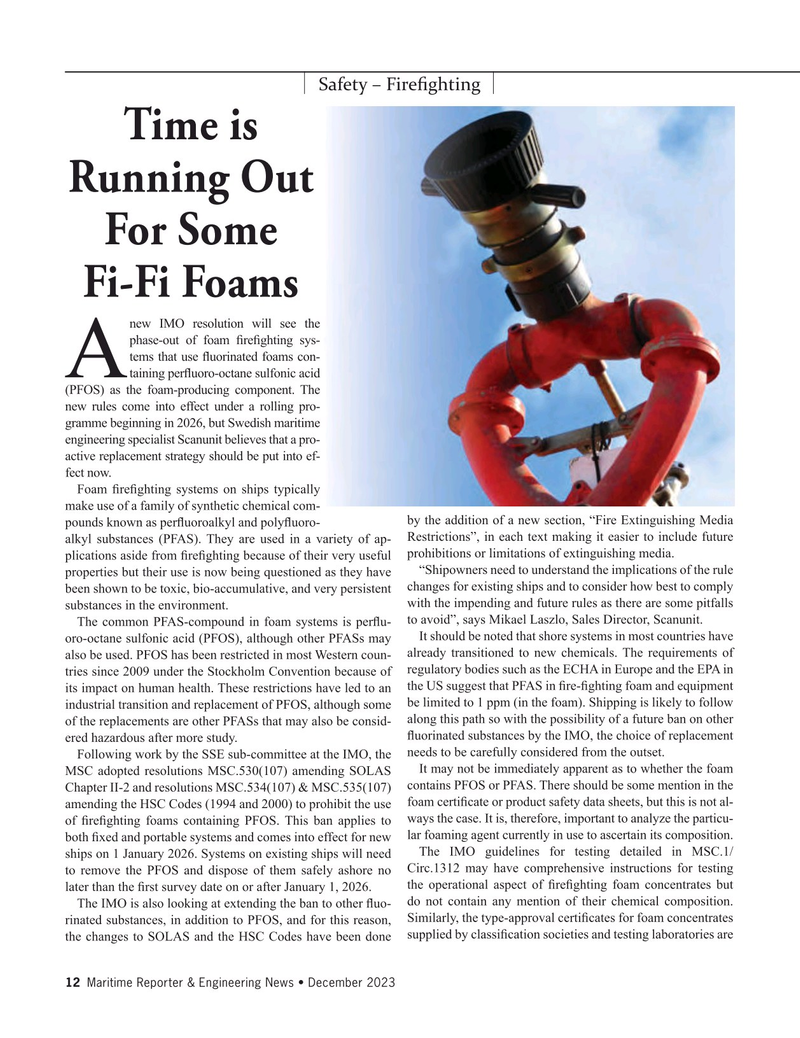
Page 12: of Maritime Reporter Magazine (December 2023)
Great Ships of 2023
Read this page in Pdf, Flash or Html5 edition of December 2023 Maritime Reporter Magazine
Safety – Fire? ghting
Time is
Running Out
For Some
Fi-Fi Foams new IMO resolution will see the phase-out of foam ? re? ghting sys- tems that use ? uorinated foams con-
A taining per? uoro-octane sulfonic acid (PFOS) as the foam-producing component. The new rules come into effect under a rolling pro- gramme beginning in 2026, but Swedish maritime engineering specialist Scanunit believes that a pro- active replacement strategy should be put into ef- fect now.
Foam ? re? ghting systems on ships typically make use of a family of synthetic chemical com- by the addition of a new section, “Fire Extinguishing Media pounds known as per? uoroalkyl and poly? uoro-
Restrictions”, in each text making it easier to include future alkyl substances (PFAS). They are used in a variety of ap- plications aside from ? re? ghting because of their very useful prohibitions or limitations of extinguishing media.
“Shipowners need to understand the implications of the rule properties but their use is now being questioned as they have been shown to be toxic, bio-accumulative, and very persistent changes for existing ships and to consider how best to comply with the impending and future rules as there are some pitfalls substances in the environment. to avoid”, says Mikael Laszlo, Sales Director, Scanunit.
The common PFAS-compound in foam systems is per? u-
It should be noted that shore systems in most countries have oro-octane sulfonic acid (PFOS), although other PFASs may already transitioned to new chemicals. The requirements of also be used. PFOS has been restricted in most Western coun- tries since 2009 under the Stockholm Convention because of regulatory bodies such as the ECHA in Europe and the EPA in its impact on human health. These restrictions have led to an the US suggest that PFAS in ? re-? ghting foam and equipment industrial transition and replacement of PFOS, although some be limited to 1 ppm (in the foam). Shipping is likely to follow along this path so with the possibility of a future ban on other of the replacements are other PFASs that may also be consid- ? uorinated substances by the IMO, the choice of replacement ered hazardous after more study.
Following work by the SSE sub-committee at the IMO, the needs to be carefully considered from the outset.
It may not be immediately apparent as to whether the foam
MSC adopted resolutions MSC.530(107) amending SOLAS contains PFOS or PFAS. There should be some mention in the
Chapter II-2 and resolutions MSC.534(107) & MSC.535(107) amending the HSC Codes (1994 and 2000) to prohibit the use foam certi? cate or product safety data sheets, but this is not al- of ? re? ghting foams containing PFOS. This ban applies to ways the case. It is, therefore, important to analyze the particu- both ? xed and portable systems and comes into effect for new lar foaming agent currently in use to ascertain its composition.
The IMO guidelines for testing detailed in MSC.1/ ships on 1 January 2026. Systems on existing ships will need to remove the PFOS and dispose of them safely ashore no Circ.1312 may have comprehensive instructions for testing the operational aspect of ? re? ghting foam concentrates but later than the ? rst survey date on or after January 1, 2026.
do not contain any mention of their chemical composition.
The IMO is also looking at extending the ban to other ? uo- rinated substances, in addition to PFOS, and for this reason, Similarly, the type-approval certi? cates for foam concentrates the changes to SOLAS and the HSC Codes have been done supplied by classi? cation societies and testing laboratories are 12 Maritime Reporter & Engineering News • December 2023
MR #12 (1-17).indd 12 12/5/2023 9:54:47 AM

 11
11

 13
13
